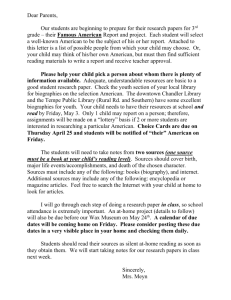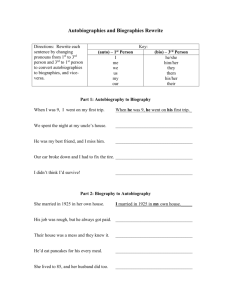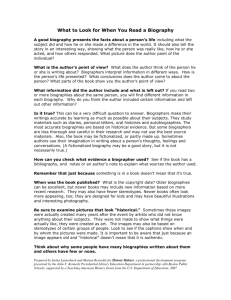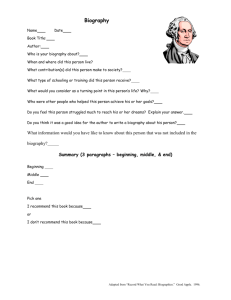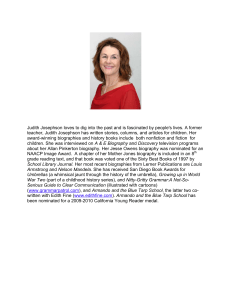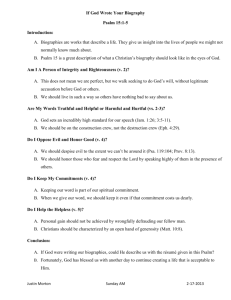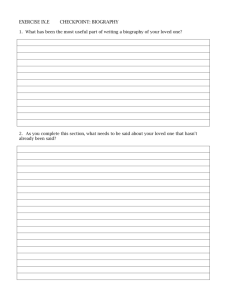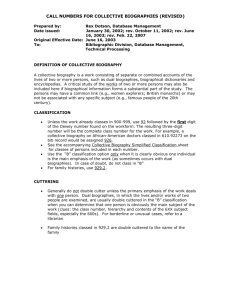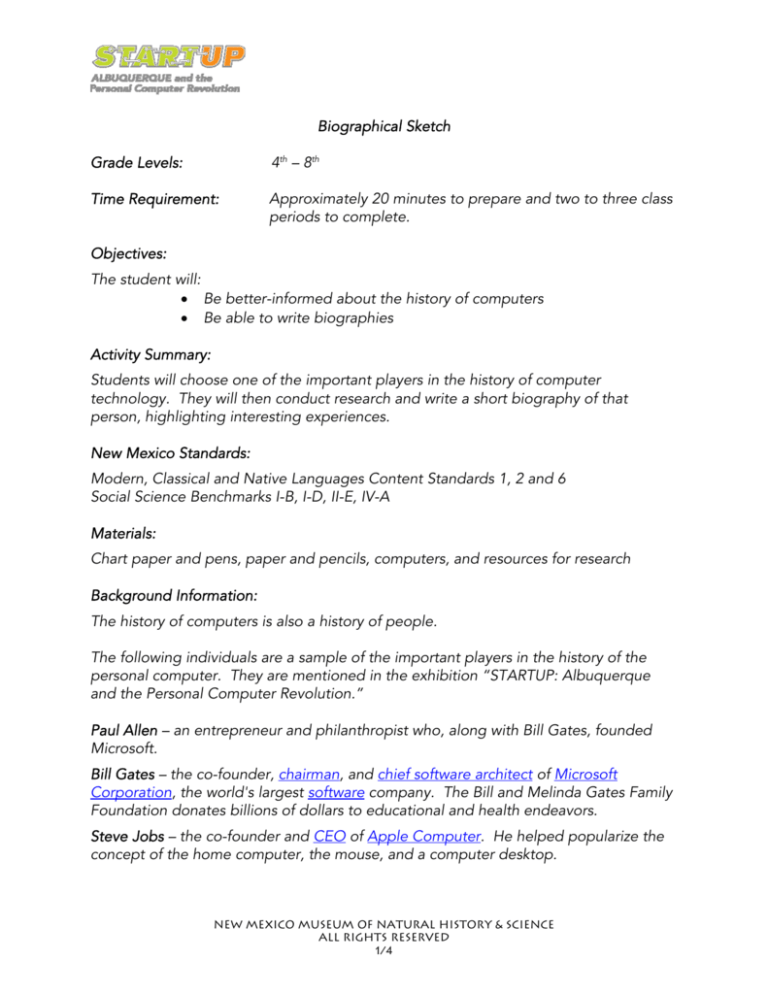
Biographical Sketch
Grade Levels:
4th – 8th
Time Requirement:
Approximately 20 minutes to prepare and two to three class
periods to complete.
Objectives:
The student will:
• Be better-informed about the history of computers
• Be able to write biographies
Activity Summary:
Students will choose one of the important players in the history of computer
technology. They will then conduct research and write a short biography of that
person, highlighting interesting experiences.
New Mexico Standards:
Modern, Classical and Native Languages Content Standards 1, 2 and 6
Social Science Benchmarks I-B, I-D, II-E, IV-A
Materials:
Chart paper and pens, paper and pencils, computers, and resources for research
Background Information:
The history of computers is also a history of people.
The following individuals are a sample of the important players in the history of the
personal computer. They are mentioned in the exhibition “STARTUP: Albuquerque
and the Personal Computer Revolution.”
Paul Allen – an entrepreneur and philanthropist who, along with Bill Gates, founded
Microsoft.
Bill Gates – the co-founder, chairman, and chief software architect of Microsoft
Corporation, the world's largest software company. The Bill and Melinda Gates Family
Foundation donates billions of dollars to educational and health endeavors.
Steve Jobs – the co-founder and CEO of Apple Computer. He helped popularize the
concept of the home computer, the mouse, and a computer desktop.
New Mexico Museum of Natural History & Science
All Rights Reserved
1/4
Steve Wozniak – a computer engineer and philanthropist whose inventions and
machines contributed to the personal computer revolution of the 1970s. He
co-founded Apple Computer with Steve Jobs.
Ed Roberts – co-founder of a company called Micro Instrumentation and Telemetry
Systems (MITS) in Albuquerque. MITS created hobby kits for building rockets and
microcomputers.
Susan Kare – the original designer of many of the icons on the first Apple Macintosh.
She designed such well-known icons as the paintbrush and the grabber. She also
designed fonts.
The individuals below, while not mentioned in the exhibition, were important early
contributors to computer history and technology.
John Napier – a mathematician and inventor of early automated counting machines.
Herman Hollerith – created a machine to handle large amounts of data recorded on
punch cards.
Charles Babbage – an inventor with the vision of creating an “analytic engine” or an
automated machine that could be programmed to perform mathematical functions.
Alan Turing – a mathematical genius and code breaker who developed foundational
concepts and theories (based on completing algorithms) that describe what modern
computers are capable of.
Konrad Zuse – working in Nazi Germany, developed the first freely programmable
computer in 1936.
John Von Neumann – a Hungarian immigrant to the United States, he was interested in
applying computer technology beyond creating charts and tables to work on specific
mathematical problems.
Procedures:
1. Prepare a list of people involved in the birth and growth of
computer technology. Next to the person’s name, write one
sentence about them as a “teaser” to assist with students’
decision-making (see background information section).
2. What are biographies? As a class, discuss the differences between
a biography and an autobiography. What information is covered in
a biography? What sort of tone might it have?
Biography Background: Authors of biographies choose or interpret
events in their subject’s life. These editorial choices about what to
highlight and what to omit present a portrait of that person, the choices
they made and the path they have taken through life.
New Mexico Museum of Natural History & Science
All Rights Reserved
2/4
3. Important players in computer history. Review the list of people
and their brief “teasers.” Are students familiar with these people?
Do they have information to share? Do students have any
questions regarding these individuals? (e.g., why did they become
interested in inventions and computers? What was their
background? What did they contribute to the field? Where are
they now?)
4. How can we find out? Tell students that they will be writing
biographies of these individuals. How might they answer the
questions they have? How and where can they find more
information about these people (interviewing them, researching
online, scanning old newspapers, reading information in history
books)? List these approaches on chart paper.
5. Students choose a person to research (and come up with a
strategy for getting more information about their subject). They
then write out this strategy as an “investigative plan.”
6. Referencing their investigative plan, students research their
particular person. Teachers may wish to reserve class time in the
library or assign homework to help students accomplish data
collection.
7. Once students have a substantive amount of data, they
write a biography about their person, noting sources they used.
8. In small groups, students share their biographies. Ask students to
highlight up to five key points they discovered in their research
that will illuminate their subject’s life experience.
9. Regroup and compare students’ findings. Just as historians
research topics and, based on their perspective, choose different
stories to highlight, biographers might focus on different parts of a
person’s life. Do students’ biographies differ in terms of the stories
they chose to focus on? How? What was the rationale behind
these narrative decisions?
Vocabulary:
Philanthropy
Entrepreneurs
Biography
Autobiography
New Mexico Museum of Natural History & Science
All Rights Reserved
3/4
Extensions:
1. Students who choose the same person may work together as a
group to prepare a PowerPoint presentation about that person.
Students may include photos, graphs, audio, and key points in
order to communicate information about their subject.
2. Students create a dramatization of their subject – introducing
themselves as that person (in costume) and explaining a little bit
about themselves to the class. What is it that makes them tick?
How would all these individuals get along if they were all at a
dinner party together?
Modifications:
1. Assign teams or small groups of students to research one
individual and then present that person to the whole class. What
are the most important moments of that person’s life? What is
their biggest accomplishment? Why?
Assessment:
•
•
•
Observation of students’ comments and participation in class
discussion
Observation of students’ interactions in small groups
Evaluation of biographies that students write
Student Datasheets/Worksheets:
List of people who contributed to the history of the personal computer (see
Background Information section).
New Mexico Museum of Natural History & Science
All Rights Reserved
4/4

